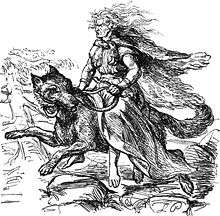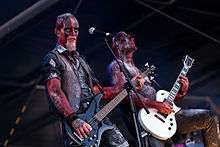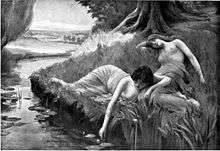Warg
In Norse mythology, a vargr (often anglicised as warg) is a wolf, especially the wolf Fenrir and the wolves that chase the sun and moon Sköll and Hati. Based on this, J. R. R. Tolkien in his fiction used the form warg, which may incorporate Old English wearh, as the name of a particularly large and evil kind of wolf that could be ridden by orcs. Through Tolkien's influence, the concept has been used in fantasy works by other authors and in other media.
Etymology
In Old Norse, vargr is derived from the reconstructed Proto-Germanic *wargaz, ultimately derived from the reconstructed Proto-Indo-European (PIE) root *werg̑ʰ- "destroy". Vargr (compare modern Swedish varg "wolf") arose as a non-taboo name for úlfr, the normal Old Norse term for "gray wolf".[3]
Norse mythology

In Norse mythology, wargs are in particular the mythological wolves Fenrir, Sköll and Hati. Sköll and Hati are wolves, one going before the sun, the other after the moon.[4]
Wolves also served as mounts for more or less dangerous humanoid creatures. For instance, Gunnr's horse was a kenning for "wolf" on the Rök runestone.[5] In the Lay of Hyndla, the eponymous seeress rides a wolf.[6] To Baldr's funeral, the jötunn Hyrrokkin arrived on a wolf.[1]
In popular culture
J. R. R. Tolkien's wargs
Tolkien's description of wargs in The Hobbit[7]
In J. R. R. Tolkien's books about Middle-earth, wargs are a malevolent wolflike race.[8] They are usually in league with the Orcs whom they permit to ride on their backs into battle, sharing any spoils. In The Hobbit, they can speak: they plan their part in "a great goblin-raid" on the woodmen's villages.[7][9]
Tolkien's wargs influenced the ten-year-old Rayner Unwin to write a positive review of The Hobbit, with the words "Bilbo Baggins was a hobbit who lived in his hobbit hole and never went for adventures, at last Gandalf the wizard and his dwarves persuaded him to go. He had a very exiting [sic] time fighting goblins and wargs." The review led his father, Stanley Unwin, to publish the book, still doubting its likely commercial success.[10]

Peter Jackson's film adaptation of Tolkien's The Lord of the Rings extend the role of wargs as mounts for Orcs, battling the horse-riders of Rohan.[11] In the Tolkien scholar Tom Shippey's view, the spelling "warg" is a cross of Old Norse vargr and Old English wearh, both words shifting from just meaning "wolf" to "outlaw".[12]
The critic Gregory Hartley treats wargs as "personified animals", along with the sentient eagles, giant spiders, Smaug the dragon, ravens and thrushes. He notes that Tolkien writes about their actions using verbs like "[to] plan" and "[to] guard", implying in his view that the wargs are "more than mere beasts", but he denies that they "possess autonomous wills".[13] T. A. Leederman calls Tolkien's wargs "a species of semi-intelligent but evil-aligned mount wolves ... on whom the orcs rode into battle". He notes that they may have been derived, in the fiction, from First Age werewolves like Carcharoth, with their own "proto-language".[14]
George R. R. Martin's wargs
In George R. R. Martin's series of epic fantasy novels, A Song of Ice and Fire, and the series' television adaptation, Game of Thrones, Wargs are skinchangers who can enter the mind of an animal (and in Bran Stark's case with Hodor, a person), see what they are seeing, and control their actions. Talented skinchangers can become greenseers, who can glimpse into the past, present, and future. An adage says that one man in a thousand is a skinchanger, and one skinchanger in a thousand is a greenseer.[15]

Other works
In 2005, a German group of musicians formed the (Viking) pagan-metal band Varg. They present themselves as bringers of a wolf-themed cult, as in their 2011 album, Wolfskult. They employ wolf-related lyrics and red and black face paint.[16]
See also
References
- Welch, Lynda C. (2001). Goddess of the North: A Comprehensive Exploration of the Norse Goddesses, from Antiquity to the Modern Age. Weiser Books. p. 220. ISBN 978-1-60925-312-7.
- Olsson, Göran. "Hunnestadsmonumentet" [The Hunnestad Monument] (in Swedish). Hunnestad.org (Village). Retrieved 10 May 2020.
Hunnestadsmonumentet kom till i en tid då makten centraliserades i Norden. Inristningen bör ha skett under en period, åren 985-1035, då Sven Tveskägg eller Knut den store hade makten i Skandinavien, eller de närmaste åren efter denna period.
- Zoëga, Geir T. (1910). "vargr". A Concise Dictionary of Old Icelandic. Clarendon Press.
- Simek, Rudolf (2007). Dictionary of Northern Mythology. Translated by Angela Hall. D.S. Brewer. p. 292. ISBN 0-85991-513-1.
- Larrington, Carolyne (1999). The Poetic Edda. Oxford University Press. p. 121. ISBN 978-0-19-283946-6.
- Acker, Paul; Acker, Paul Leonard; Larrington, Carolyne (2002). The Poetic Edda: Essays on Old Norse Mythology. Psychology Press. p. 265. ISBN 978-0-8153-1660-2.
- The Hobbit, ch. 6 "Out of the Frying-pan into the Fire"
- Evans, Jonathan. "Monsters". In Drout, Michael D. C. (ed.). J.R.R. Tolkien Encyclopedia: Scholarship and Critical Assessment. p. 433.
- Sookoo, Lara (2013) [2007]. "Animals in Tolkien's Works". In Drout, Michael D. C. (ed.). J.R.R. Tolkien Encyclopedia: Scholarship and Critical Assessment. Routledge. p. 20. ISBN 978-0-415-86511-1.
- Moseley, Charles (2018). J.R.R. Tolkien. Liverpool University Press. pp. 7–8. ISBN 978-1-78694-682-9.
- Bogstad, Janice M. (2011). Bogstad, Janice M.; Kaveny, Philip E. (eds.). Concerning Horses: Establishing Cultural Settings from Tolkien to Jackson. Picturing Tolkien: Essays on Peter Jackson's The Lord of the Rings Film Trilogy. McFarland. p. 244. ISBN 978-0-7864-8473-7.
- Shippey, Tom (2005) [1982]. The Road to Middle-Earth (Third ed.). HarperCollins. p. 74, note. ISBN 978-0261102750.
- Hartley, Gregory (2014). "Civilized goblins and Talking Animals: How The Hobbit Created Problems of Sentience for Tolkien". In Bradford Lee Eden (ed.). The Hobbit and Tolkien's mythology : essays on revisions and influences (PDF). Part III: Themes. McFarland. pp. 33–34. ISBN 978-0-7864-7960-3. OCLC 889426663.
- Leederman, T. A. (2015). Jes Battis; Susan Johnston (eds.). A Thousand Westerosi Plateaus: Wargs, Wolves and Ways of Being. Mastering the Game of Thrones: Essays on George R.R. Martin's A Song of Ice and Fire. McFarland. p. 190. ISBN 978-0-7864-9631-0.
- Chintaluri, Amulya. "From Page to Screen—Why did Game of Thrones cut the Stark children's warging abilities?". Winter is Coming.
- "Biographie: Warg" [Biography: Warg]. Varg.de (in German). Archived from the original on 23 January 2015. Retrieved 9 May 2020.

.jpg)